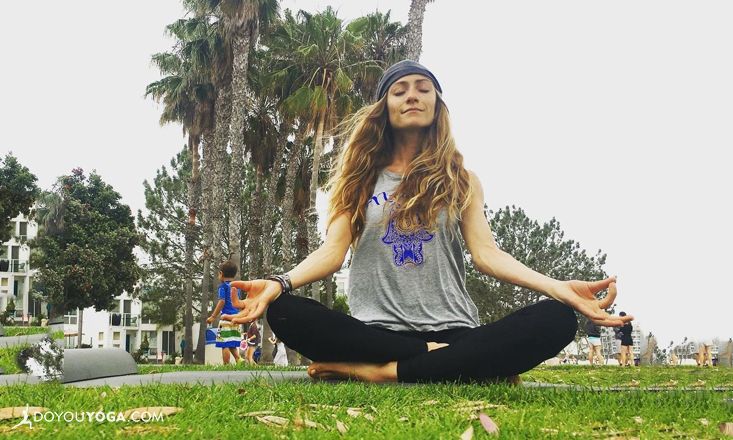Did you know that anxiety is considered to be the most common mental illness in the United States? Almost 20% of American adults live with anxiety. Panic disorder, a specific and severe form of anxiety, affects 6 million Americans. Not surprisingly, yoga can help people who experience anxiety and panic attacks to decrease their symptoms and reclaim their lives.
A recent Harvard Mental Health report found that yoga helps people living with anxiety to gain control of their body’s stress response. A recent study in a peer-reviewed psychiatric journal concluded that yoga significantly decreased the symptoms of panic disorder.
If you live with anxiety or panic disorder, read on for some things to consider as part of creating a yoga practice that best serves your unique needs.
Start Where You Are
There are many different versions of yoga asana, the mat-based postures that are most well-known in the West. For example, hot yoga is a very athletic style of yoga practiced in a heated space. Restorative yoga might be considered the opposite of hot yoga. Students move through only about five supported poses in a one-hour class to induce a state of deep relaxation.
There are countless styles in between these two examples. Assess your physical fitness level and begin there. If you’re not sure where to begin, reach out to a yoga teacher or comment below for additional guidance. Pushing yourself beyond your boundaries will only increase stress. Honor where you are now and start there.
See the Big Picture
The postures (asana) of yoga are only one small part of this ancient science. Other aspects of yoga include breathwork and meditation, both of which are fantastic tools to support individuals living with anxiety and panic.
As you embark on a yoga practice, be open to trying aspects of yoga other than asana. While moving the body is fantastic for overall health and wellness, it is only one piece of the puzzle. Some of my most transformational yoga moments have come in other areas of practice.
For example, the yamas and niyamas are part of yoga philosophy. They offer guidelines for living a happy life. Ahimsa, the first yama, guides us to do no harm to ourselves or others. Some people might wish to start their yoga practice by reading The Yoga Sutras to enlighten themselves about yogic philosophy.
Belly Breathing
One of my favorite breathing practices is called belly breathing. It’s easy to learn: close your eyes (if that feels comfortable) or keep your gaze soft toward the ground. You can be seated, standing, or lying down.
Inhale through your nose and feel as if your belly is filling up like a balloon. Exhale through your nose and allow your belly to soften toward your spine. That’s it! Repeat for as little as a few breaths or as long as twenty minutes, always being sure to listen to your body and mind. The beauty of belly breathing is that you can practice it anywhere, even when you’re standing in line at the grocery store.
Mindfully Meditate
I work with a lot of people who’ve been told they should meditate to help support them in their mental health. Meditation is awesome. Try starting with just one minute each day. Close your eyes and notice your thoughts.
I often like to do a naming practice. Categorize each thought that appears as past, present, or future. For example, if you’re like me and you notice that when you meditate, you start thinking about your next meal, name that as “future.” By naming the thought, you are learning the critical skill of detaching from it.
Just as you would with physical exercise, slowly build your meditation practice by adding an additional minute or two each week.
Turn Things Upside Down
When I’m experiencing anxiety, one of my tried and tested methods for relief is to elevate my legs over my heart. In yoga, there are all sorts of fancy inversions that you can practice. I recommend keeping it simple with Legs Up the Wall pose. You can even do this on your bed.
Simply place your bottom against the wall and lift your legs up into the air, resting them against the wall for support. If having your legs straight is uncomfortable (which can happen if your hamstrings are tight), you can bend them.
Another option is to lay on your back on the floor next to your bed and swing your legs up onto the bed with knees bent. The backs of your calves should rest on your bed. Place your right hand on your heart and your left hand on your belly. Breathe here.
As you shift the flow of energy in your body, allow each exhale breath to soften you from the inside out. Feel as if your back is melting into the bed or the ground beneath you. Consider adding in your belly breath for an extra dose of relaxation.
If you’ve chosen the path of yoga to help you manage your anxiety and/or panic, make sure to discuss your plans with your doctor or therapist. Then, remember that consistency is key. Create a plan for your week that allows time to try these practices in addition to using them on the fly as needed.
While I can promise you that yoga will change your life for the better, I can’t promise you that it will happen in an instant. Be patient and gentle with yoga and with yourself as you begin this journey.
Image credit: Heather Gjerde


